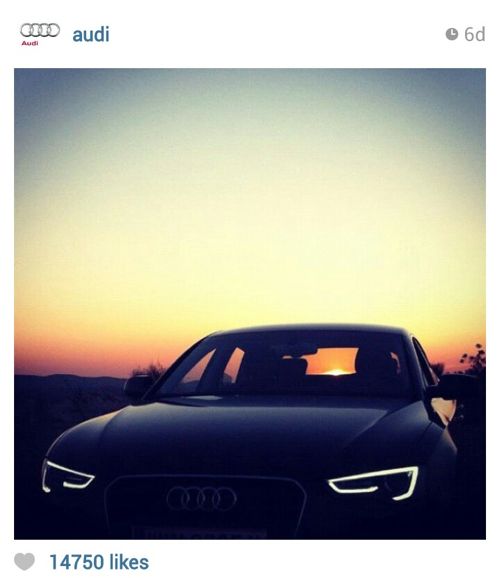Instagram is used by 40 percent of big brands, but only Audi uses it correctly

Social media analytics company Simply Measured released a study this week that illustrates the importance of brand presence on Facebook's photo-sharing social network Instagram. According to the survey, the nearly two- year old social network, with its 80 million users, has managed to attract the attention of 40 percent of the top 100 global brands.
Instagram’s adoption accounts for 40 percent of the Interbrand 100, which is actually the lowest in the study, but it has the most impressive adoption rate, when considering the background of the company. Instagram is currently owned by Facebook, through a $1 billion deal announced 4 months ago. The reason why a billion dollars was significant was because Instagram only had a dozen or so employees, and hadn’t generated any revenue.
Instagram currently has over 80 million users, and is expected to reach 100 million "by early fall." Despite until recently being available only on iOS, it has racked up more than 10,000,000 installs on Android in just a few months. According to Simply Measured, it took Facebook four years and Twitter five years to reach that many users. Instagram could do it twice as fast as Facebook did, and two and a half times faster than Twitter.
Facebook, has 955 million users, has managed to attract 98 percent of the Interbrand 100. Twitter, which has more than 500 million users, comes in second with 94 percent Interbrand 100 adoption. The two major social networks are the only ones with a higher than 90 percent adoption, with Google+ ranking in third with 64 percent despite the 250 million users it has. In fourth place, before Instagram, is Pinterest with 51 percent adoption from Interbrand 100.
Who's the most popular brand?
MTV and Starbucks Coffee dominate the charts, but MTV is at the top of the list with 813,201 followers, a total of 478 photos, 3,477 likes received, and a total of 88 comments from Instagram users. Starbucks Coffee has almost 60,000 fewer followers (758,146), 202 total photos, more likes at 3,812 and it has received 69 comments.
MTV and Starbucks Coffee occupy the first two places with more than 750,000 followers, with Starbucks Coffee having more than 300,000 followers separating it from Burberry, in third place.
At the 3rd place from the bottom of the list, but still with more than 100,000 followers is Tiffany & Co. with 103,356 followers, 159 total photos, 1,676 likes and 32 comments. Hermes is on penultimate place with 51,136 followers, 303 total photos, 281 likes and 4 comments. On last place is McDonalds, which pales in comparison to the other 9 brands from the top 10, with 38,141 followers, 7 photos, 0 likes and 0 comments received.
McDonalds is last on all counts, while Burberry has the highest number of photos, Nike has received the highest number of likes, 6,399 and the highest number of comments, 135, despite being in fourth place with 322,721 followers.
Luxury brands such as Burberry, Audi, Guccy, Tiffany & Co and Hermes are in the top 10 most popular brands, with others such as BMW and Armani making an entrance in top 15, being on the 10 – 15 spot when it comes to total engagement.
60 percent of photos posted on Instagram by the brands on Interbrand 100 are filtered, with the “Valencia” filter having the highest engagement and a 7 percent usage and with “Lo-Fi” having the highest usage at 14 percent. It appears as if there is no recipe for success when it comes to the use of filters and instead there’s “room for trial-and-error” and optimization based on individual brand strategy.
Out of 1,736 photos posted, the engagement per photo is 4,028 actions. 32 percent of photos posted to Twitter receive 27 "engagements" (tweets/retweets/etc) per photo, but on Facebook, engagement is 40 (shares/likes/etc) per photo. The study suggests that there is a strong connection between the number of followers and engagement per photo, but the same rule doesn’t apply when it comes to the number of followers and the engagement as a percent of those followers. It’s been stated that the weak connection between followers and the engagement among them can be attributed to the lack of a "share" button, which isn’t present on Instagram as it is on Facebook.
Out of the Interbrand 100 brands using Instagram, Audi appears to be the most successful and the one that does what they are supposed to on a photo-sharing website: they post photos. They focus on posting pictures of their cars, which is their core product after all. But what the car manufacturer doesn’t do is announce deals, promotions or sales on Instagram, or direct their followers to Facebook contests. Basically Audi manages to have 4.5 engagements per follower on Instagram since June 20 2012, averaging 1,423 likes and 34 comments per photo; they also post once a day which helps keep momentum. According to the study, Audi manages to be much more effective when it comes to engagement on Instagram even if they have 104,511 followers, a relatively modest showing compared to MTV or Starbucks Coffee which have more than 7 times as much.
There are a few lessons to be learned when it comes to Instagram use, and one of those lessons comes from Audi. Judging by what Audi is doing, the key to success is to do what’s expected on a photo-sharing social network: share photos. Instead of utilizing it as a direct marketing tool, they use it properly. When it comes to the photo filters, it's not the most used that bring the highest engagement, but the use of the right filter that triggers an action from the users. Third, bigger isn’t necessarily better, and Audi’s numbers prove it. It's not the number of followers that bring the highest engagement on Instagram, but instead it's a combination of regularity of posting, the content of what's posted, and how it looks.